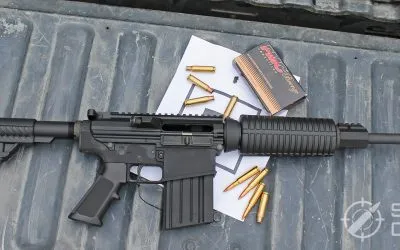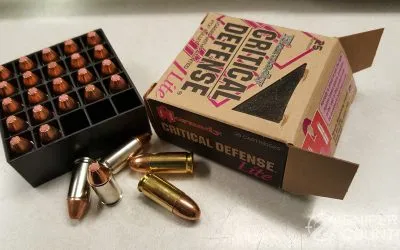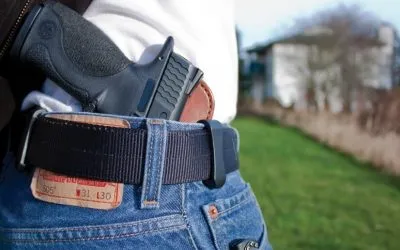The Ruger Scout rifle started with Jeff Cooper.
In case you don’t know who Jeff Cooper was, allow me to point you to a website that will help you understand what this former Marine Lt. Colonel contributed to the shooting sports.
Part shooter, part statesman and part philosopher, Jeff helped found what became Gunsite Academy in Paulden, Arizona. He has been a major contributor to modern pistol craft techniques and was a major proponent of the 1911 as the ultimate fighting handgun. While sadly he died in 2006, his precepts and teachings are still current to this day and are taught at Gunsite (and many other schools have adopted his methodology).

Our interest in the Colonel has to do with his “scout rifle” concept. In 1983, he convened what he called the “First Scout Rifle Conference” at Gunsite, with a second one held in October, 1984. He gathered gunsmiths, people who made rifle stocks, journalists, hunters ... just about anybody with an interest in creating a new-type rifle. The conclusion was the “Scout Rifle”.
BONUS OFFER: Get your free shooting range targets to print at home!
Get your free targets to print at home!
Why a scout rifle?
scout n.
'A soldier or other person sent out ahead of a main force so as to gather information about the enemy's position, strength, or movements.'
The Oxford Essential Dictionary of the U.S. Military
A scout needs a light rifle that is easy to carry and shoot. Whether you're a scout for the infantry or a scout for your hunting party doesn’t matter - the mission is essentially the same, even though the quarry is different.
The concept of a short, light rifle with quick-acquisition sights and fast reloading capability was not exactly unknown at the time. After all, game guides had used similar guns for a good while, not to mention what are called "mountain rifles". However, Jeff's conference in 1983 codified what a scout rifle should look like and how it should be built.
Scout rifle specs
| Caliber: | 7.62x51 (.308) is preferred, with 7mm-08 acceptable. |
| Action: | Bolt action. The two-lug Mauser action with its claw extractor was preferred. |
| Trigger: | A trigger pull of 3 pounds that broke cleanly was specified. |
| Weight: | Between 6.6 and 7.7 pounds - no more. The gun was designed to be very easy to carry. |
| Length: | One meter (39”) or less. |
| Optics: | A long-eye-relief scope was to be mounted forward so as not to interfere with loading. An aperture-type adjustable rear sight with a front protected post was provided in case the scope failed. |
| Stock: | If detachable, it should have two detents: the first for carry, where the bolt will not load a round and the second for full insertion when ready to fire. |
| Sling: | A “Ching Sling” was preferred, as it allowed both the carrying of the weapon but also was brought into use to steady the shot. Cooper was one of very few at the time to advocate using a sling to help steady the shot, aside from competitive shooting. |
| Accuracy: | 2 MOA, 3-shot groups. This equals 4-inch groups at 200 meters/yards. |
| Magazine: | If detachable, it should have two detents: the first for carry, where the bolt will not load a round and the second for full insertion when ready to fire. |
We see that this rifle was intended to meet some very specific design points. There are a few Scout rifles out there today, but Cooper worked with Steyr to build the first of these concept guns. Scout rifles have been made, or are currently being made, by at least the following companies:
- Steyr
- Savage
- Ruger
- Mossberg
- Howa
The common caliber among the Scouts is .308. However, Ruger does offer one in .450 Bushmaster - talk about a handful!

So how does our Ruger stack up against the given, preferred measurements? Let’s take a look…
| Caliber: | 308 Winchester/7.62x51 (.450 Bushmaster, .350 Legend available) |
| Stock: | Black Laminate |
| Front Sight: | Protected Blade |
| Rear Sight: | Adjustable aperture-style |
| Scope Mounts: | Machined into receiver; rings included |
| Capacity: | 10 (5- and 3-round magazines are available) |
| Muzzle Thread Pattern: | 5/8"-24 |
| Barrel Length: | 18.7" |
| Grooves: | 6 |
| Overall Length: | 39.50" - 41" (three ½” buttpad spacers are included) |
| Material: | Stainless Steel |
| Finish: | Matte Stainless |
| Safety: | Three-position |
| Barrel Feature: | Flash Suppressor |
| Length Of Pull: | 12.75" - 14.25" |
| Twist: | 1:10" RH |
| Weight: | 7 lbs, 6.2 oz. with empty mag (my digital scale) |
| Trigger Pull: | 5 lbs., 8.5 oz. (my trigger scale) |
| MSRP: | $1199.00 |
| “Real-World (non pandemic)” Price: | ~$800 |
What use is a Ruger Scout Rifle?
Why buy such a gun as this? Whatever would you use it for, especially since there are so many other, fine “regular” rifles out there? I can think of a reason or two.
As it should be, it is easy to handle and aim
First, we need to realize that not everybody can handle a large, heavy rifle easily. I know that when I pick up a Ruger Precision Rifle (RPR), I feel just a bit overwhelmed. I have one in .308 at home now, with one in 6.5 Creedmoor coming to review. If a shooter was six feet tall or better, there would be no problem wielding the longer RPR but shorter guys or gals like me might have a bit of a problem. The Scout is just the right length for me.
Second, tied to the length issue is the fact that longer guns are harder to handle, especially in the field as you make your way to your deer stand or varmint location. Heck, even just shooting the guns off my bench is easier if they are shorter. It seems like I’m always getting the rubber butt pad of a longer, heavier rifle “caught” on this or that (usually my shirt) as I maneuver it to shoot.

Its weight is just about right
Third, the rifle’s weight is just about right. Seven pounds is a good weight for a rifle in .308. Six pounds is a bit light, while much above 8.5 - 9 pounds seems to be a bit of overkill. Seven pounds is easy to tote around yet still gives you some felt-recoil reduction.
Lastly, many shooters feel that ballistics suffer greatly in the shorter, 18.7-inch tube. I don’t think they do, at least not as much as some folks think. I found a table here (from rifleshooter.com) where they clocked the velocity of a 6.5 Creedmoor as they cut an inch off the barrel until they got it down to 16 inches. They started out with a 27-inch barrel.
An 18.7 inch barrel maintains good muzzle velocity
This was very interesting, but if you scroll down, you’ll see a .308 comparison table. The upshot of their research was that a .308 shows an average loss of around 23 f.p.s. per inch of barrel reduction when 30 shots were compared and averaged that were fired out of both a 28-inch barrel and a 16.5-inch barrel. I’m probably not explaining this very clearly, but you can go to the page and read it for yourself. The point is, an 18.7-inch barrel will not lose as much velocity as you might think.

Popular Articles
A good hunting companion
So, we see that the Scout rifle might be enough gun to be your main artillery for an upcoming hunting season. What it is not designed to do, to be honest, is to be a long-range competition gun. The whole purpose of the Scout is to be quick into action, to engage man-sized targets out to 400 yards with the open aperture sighting system installed as a back-up if your L.E.R. scope went down. At least, that was the intent. For what it is, it works admirably. If you want a traditionally-mounted scope, mounts are machined into the receiver and rings are included.








BONUS OFFER: Get your free shooting range targets to print at home!
Get your free targets to print at home!


Two-position safety. The rounded cutout below the rear sight is part of the machined scope mount area.

A good shot of the magazine. Note the two action bolts.

The magazine release. A quick push forward and the mag pops out.


Shooting the Ruger Scout Rifle

Let me say right up front that I don’t own a .308 so my ammo situation is pretty bleak.
When I found out that I was going to be sent a couple of .308s to review, I started looking for a box or two of factory ammo (since I don’t reload this caliber) that I could at least poke a few holes in paper with. So, at my local Academy Sports, I found two boxes (the limit I could buy) of Russian Monarch steel-cased ammo. I know that's not the best, but it's what they had.
It uses a 147-grain FMJ at around 2745 f.p.s. I honestly didn’t chronograph it to see how the box’s stated velocity held up when shot out of the 18.7-inch barrel, so we can only wonder. I did fire five shots at a target 50 yards away. (Why not 100? Well, because the shots would’ve been off the paper at that range after seeing how low they printed so I just stuck to 50 yards.
If ammo was not an issue, I’d have gone to 100 yards, easily, but I just know that my eyes see sights differently than almost everyone else and I do tend to go through a lot of ammo. I’ve ordered a bore sighter but don’t have it yet. Anyway, even with my wonky ability to look through sights and actually put holes in the paper, I was rather pleased with the target I’m showing here.

Target Analysis
Four of the five shots went into basically one hole, with one flyer stretching it out. This rifle would be a great candidate for more testing. Put it in a bench rest, lay 4 or 5 different brands and types of .308 ammo down on the bench, and have fun. The nice part about the above group is that you could adjust the bullet impact via the adjustable rear sight. Of course, if you are using a scope or red dot, adjustment is easy. I had a red dot I could’ve put on the gun, but I wanted to try the sights already on there.
I have a feeling that if I had waited until later in the day to shoot, the sun wouldn’t have been behind the target stand. It made it a bit hard to focus. But, with our recent cold-and-lousy weather, the sunshine was welcome. At any rate, I’m sure that the gun’s more accurate than I am.
I usually get slightly better results when I use the old-fashioned “peep” sight, like the one on this gun - it has to do with how my eyes focus. I’m sure that’s why the military uses this type of sight as its “ground zero” in terms of optics - it is fairly easy to teach recruits to just look through the ring, basically ignore it, while your eye automatically centers the post in the ring. Put the post on the target’s aiming point and let fly.
A nice grouping with those 5 shots
I actually am kind of impressed that I put four of the five as close together as I did. I’m usually not the best shot in the neighborhood. (What helps is that my neighborhood consists of racoons, squirrels, deer and coyotes so the competition isn’t very fierce). At any rate, the gun handled recoil well - the older I get, the less I like recoil - and was fun to shoot.
I put the gun on an MTM Shoulder-Gard rest and pulled it in tight. After I was done shooting, I took it inside and ran a patch through the bore. I always clean guns after I shoot, especially if they don’t belong to me. A tiny dab of oil where needed and a wipe-down and the gun was good to go.
That’s one thing about stainless guns - they can rust, but you really, really have to neglect them for a long time in order for them to do so. Plus, they gather fingerprints like blued finishes but they don’t show as readily as they do on the darker background.
Small Features, Big Impact
There are a couple of design features with the Scout rifle that I appreciated, nothing major but things that helped me use the gun a little more easily. One thing I appreciated about the Ruger is the bolt release. Simply swing it out and remove the bolt. I wish my Savage Axis IIXP had that feature - you have to press the bolt release and hold the trigger in at the same time in order to get the bolt out.

Another thing I liked were the magazines and magazine covers - it has two 10-round glass-filled nylon magazines in the box and they each come with a pop-off-clip plastic cover that goes over the top of the magazine. In true Scout rifle tradition, the mags will be protected as they travel about. The cover protects loaded magazines’ feed lips and are easy to put on or take off. Also, if you don’t like the way the 10-rounders hang down, you can get Scout rifle magazines in 5- and 3-round flavors. The 3-rounder is about as close to a flush fit as you’ll find, the one mag of the three that would allow you to carry the gun at its natural balance point.
Ruger Scout Rifle in Summary
As I end this review, allow me to wax eloquently about the overall handiness and effectiveness of this rifle for a moment.
As I have stated in many different reviews I’ve done, I am not primarily a rifle guy - I “cut my teeth” on handguns, both pistols and revolvers some 40-odd years ago. So, when I find a rifle that I shoot decently well, that’s rare.
This gun just worked for me, even with the limited amount of shooting I was able to do with it.
I own an AR in 5.56 and the above-mentioned Savage in .243 - that’s the extent of my centerfire long guns, if you don’t count the Diamondback 9mm AR. I have owned, over the years, different long guns including a Turkish “German Mauser” K98 copy and a Lee-Enfield .303. To further my experience with long guns, I do have a Bear Creek Arsenal AR-15 in 7.62x39 coming, so be on the lookout for that review. My rifle shooting experience is growing, even if my rifle reloading isn't.
To be honest, the reloader in me would rather dump 5 grains of powder into a pistol case rather than 55 grains into a rifle case - economics has a hand in it, especially nowadays.
But… if I were to have my ‘druthers, this Scout rifle would stay here. Take that as a pretty strong compliment about the gun. I’ve had many long guns that I offered to review that were definitely not my cup of tea and went back post haste. Maybe it’s the shorter length or the lighter weight - this gun is a keeper. Every shooter I show it to drools all over it and gums up the bolt…
If you own one of these (or if you want to), let us hear from you below. As always, keep ‘em in the black and stay safe!










![9mm Glock Models [Ultimate Guide]](https://snipercountry.com/wp-content/uploads/2018/10/Glock-17-vs-Glock-19-vs-Glock-26-vs-Glock-41-vs-Glock-43-WM-400x250.webp)
![Handgun Caliber Chart [2025 Ultimate Guide]](https://snipercountry.com/wp-content/uploads/2018/10/Handgun-Caliber-Comparison-400x250.webp)
![Rifle Calibers [Ultimate Guide]](https://snipercountry.com/wp-content/uploads/2018/12/Header-1900-400x250.webp)






6 Responses
Mike does Ruger still make this in a lefthander? As a lefty do you prefer a left handed action or right?
Doug, you will be happy to know that they do make a southpaw version of the Scout in .308. They also make some Hawkeye and Americans that way, as well. I prefer right hand rifles only because that’s what I’ve gotten used to although I would like to try some more lefty models. Thanks for the questions!
Thanks, to the point without BS. respectfully Dana.
Dana, appreciate your comment. I get tired of the BS I read, so I try really hard not to include any. Thanks for writing!
For as long as I can remember I hated shooting because I’m left handed I finally got my money put together and purchased my dream guns left handed gsr
The to add insult to injury I put less than a box of shells through it and then in 2018
I had a stroke and lost my dominant left hand and now I’m not sure I can work my mint gsr
Chris, wow! Too bad. Hopefully you can recover to the point where you can shoot it again… we are all pulling for you. Thanks for writing!